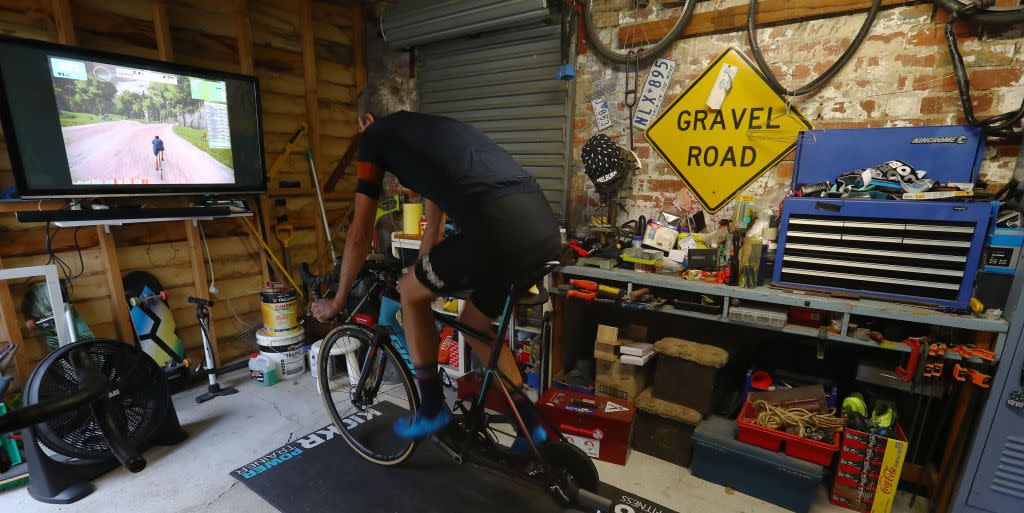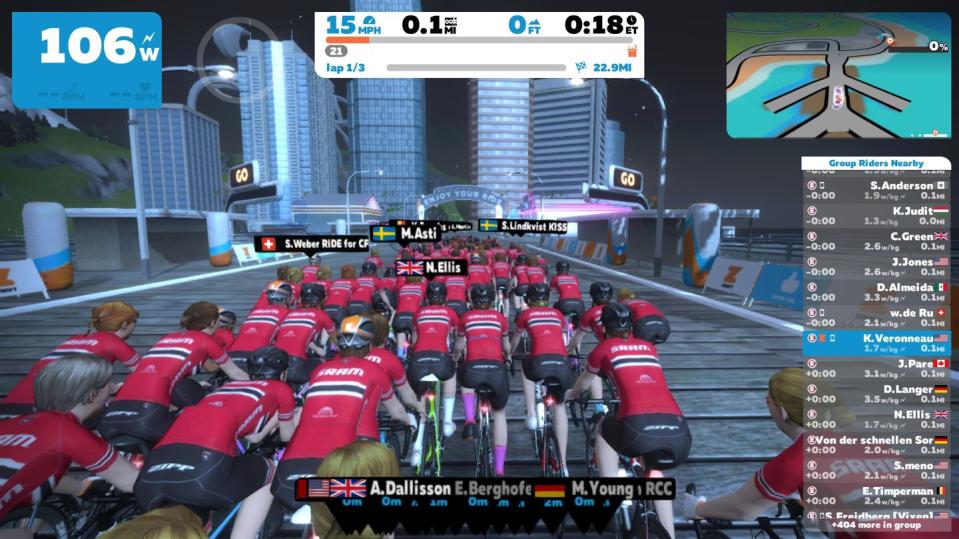Thinking of Cheating on Zwift? These People Are on to You

Renee Baran shifted gears on her Fuji Roubaix Pro, took some deep breaths, and put her head down, sweat cascading onto her top tube. She was trying to hang onto her teammates’ wheels as they steeled themselves for the big climb of the day. Her team—Team Fearless—was leading the charge. She scanned the pack for signs of any moves they needed to cover.
With no riders attacking at the moment, she took a quick glance at her daughter, just ahead and to the left in her field of vision, practicing her piano lessons for the week. Then she directed her full attention back to the task at hand—the looming KOM climb.
Because this wasn’t your typical race: Baran, who lives in the Pocono mountains of Pennsylvania, was actually in her study. She was competing in a SRAM-sponsored women’s stage race on the virtual training program Zwift in 2018.

The Zwift Women’s Tour was technically a self-paced ride, not an official race. But when there are 600 to 800 riders, a finish line, and a clock, you know you’ve got a competition; and women like Baran and her teammates were treating it as such. This ride was particularly appealing: Participants would be eligible to win big real-life prizes like a SRAM eTAP group, and, if you completed any one of the four stages, the points to unlock a sweet new SRAM kit for your Zwift avatar.
This stage ran around the Watopia Big Loop, so it included the massive KOM Climb and the Mayan jungle portion of the course. Baran was near the front of the virtual pack when another rider shot by. She didn’t recognize her kit, so she asked her teammates if anyone knew her.
“My teammates thought maybe she was trying to bait me early. I didn’t want to blow up chasing her so I stayed back,” Baran said. “I was watching her numbers, thinking she’d surge and then even out and I’d catch her. But she kept climbing and climbing.”
Then Baran noticed that the competitor in question had a fairly masculine avatar…and a guy’s name. One of her teammates looked him up. “She said, ‘That woman has a pretty serious goatee.’ That’s when we knew it was a man.”
They were right: Sean Smith, a racer and avid Zwifter from the Philadelphia area, had seen an announcement for the Tour, and wanted that hot red kit. So he swapped his gender for the day and hopped in to ride Stage 2 of the Tour to unlock some new cycling clothes for his avatar.
Smith hit the summit’s arch first, bagging the QOM. So Baran took a screenshot of his altered profile, which she posted to a closed Facebook group of female Zwift racers. Much to her surprise, this wasn’t an isolated incident. Other women jumped into the discussion with similar stories accompanied by similar screenshots. Word got out that there was a man who won a full stage outright. He got slapped with a temporary ban.
If you’re surprised, confused, maybe a little stunned by all this, join the club—and buckle up. As the popularity of Zwift has grown over the past several years, life has gotten a little complicated on this rapidly growing island where fantasy bashes up against reality in sometimes mind-boggling ways.
A Zwift Ascension
Zwift rolled out in 2015 as a fun interactive way that cyclists, generally stuck indoors rolling away the hours watching the Godfather series (again), could virtually ride and train with others during the cold, sloppier months of winter.
To make it engaging, the company created a fantasy world called Watopia, where you could ride up an epic climb, pedal around a volcano, traverse the Mayan Jungle, and enjoy an ever-changing landscape, complete with variable weather. You could pedal alone, meet up with a friend, or jump in a group ride, where through some clever engineering, you could even catch a draft and your efforts would feel easier as you motored at the same pace. The training app would eventually introduce other routes like the London Prudential and Richmond 2015 World Championship courses.
It’s a great way to stay entertained while getting a hell of a workout. All you need to join the fun is a trainer or a set of rollers and a way to connect—a Bluetooth or ANT+ measurement tool like a smart trainer, power meter, or speed/cadence sensor and your computer, smartphone, or tablet with Bluetooth or ANT+ (or an ANT+ USB dongle) all do the trick.
Hundreds of thousands of people from around the world showed up. To date, more than 3 million accounts have been created on the platform, and CEO Eric Min told Forbes that business doubled during the pandemic in 2020. Any time night or day, you can find a massive animated peloton plowing around Watopia. To keep the masses entertained, Zwift started throwing events. You could do a group ride with Geraint Thomas. You could do some pre-programmed workouts. You could join various scheduled group-training rides. Heck, you could toe the line and race.
And a funny thing happened: People who never in a billion years would race their bikes were suddenly bumping bars on Watopia. People were riding their trainers instead of riding outside. Zwift teams formed and people were logging their stats on Zwiftpower.com, a third-party app that has become vital for many users. Zwift has also livestreamed virtual races and reached hundreds of thousands of viewers.
People used Zwift to train and measure their performance, to come back from injuries, to work through messy divorces, and funny enough, to just have fun. Massive-scale Zwift training and racing had become a real thing.
But unlike races in real life, where you know a lot of your competitors or can at least glance around and check the start list and know who you’re up against, Zwift (outside of the Zwift Academy, which carefully vetted all riders) presented a sea of pixelated unknowns.
“A lot of people were enjoying the racing, but it was hard to know who you were racing against. Who were they? Where were they from?” says Casey Schumm, of Peoria, Illinois, a Cat 4 racer and avid Zwifter who has logged nearly 50,000 miles and more than 700 races on Zwift since 2014.
The rising popularity of racing also brought an increase in social media grousing over whether or not certain race performances were “real.” Some of the shenanigans were obvious, like riders swapping genders to earn points. Others were not so transparent. Racers were competing against other supposed amateurs, but those everyday Janes and Joes were posting up pro-level power numbers. And so a volunteer policing organization, of which Schumm was a member, was born in the early days of Zwift: ZADA, the Zwift Anti-Doping Agency. (Later the are handed down by the Zwift Accuracy and Data Analysis.)
The Big Brothers of Zwift Racing
Yes, you read that right. The make-believe island of Watopia has a real life “anti-doping” agency. They’re there to authenticate Zwift riders who are performing at the elite level. (ZADA is now run by a team of Zwift consultants and employees, and decisions are handed down by the Zwift Performance Verification Board.) When the group first started in 2016 as a community effort, they clarified their purpose on zwiftinsider.com (an online news site for Zwifters) as such:
The purpose of ZADA is to have an objective, impartial review of whether someone’s performance is plausible rather than have long Facebook threads of uninformed opinions on whether not a performance is real.
Laugh if you want (it is kind of funny). But while to some Zwifters these cartoon circuit races are just a game, to an increasing number, especially those going for big IRL prizes, they’re far closer to a superprestige than Super Mario. To them, an even playing field is important, and the plausibility and authenticity of some Zwifters’ performances and power numbers can be suspicious, drawing that playing field into question.
Of course “Zwift Doping” doesn’t necessarily mean riders are using banned substances (no one is coming to your door with a plastic cup asking for a sample when you win a big Zwift race). Instead, it’s generally a product of a user’s power numbers (and thereby avatar speed) being incorrect due to faulty data (like incorrect body weight) or user setup, whether intentional or unintentional.

Problems generally arise with what Zwift calls the “power curve,” which is what ultimately determines the speed and power numbers your avatar puts out around Watopia. Since not everyone has the same power-equipped smart trainers, the folks at Zwift headquarters have tested dozens of makes and models of classic trainers with power-meter equipped bikes to create a “power curve” for each trainer. When you set up your Zwift account, that information is combined with your personal data, such as weight, and plugged into a complex algorithm that determines your speed at any given time and effort.
But the system is open to a considerable amount of user error, notes Glen Knight of the a results hosting website and community hub ZwiftPower.com. That’s where ZADA comes in. They have developed a race governor that automatically disqualifies a racer who is churning out pro-level wattage until they can verify those figures with real life power meter data. The ceiling is set at 5.2 watts/kg for 20 minutes or 6.0 w/kg effort for 5 minutes. For reference: Top-shelf pros can hold down about 5.5 watts/kg (women) and 6.5 watts/kg (men) for 4 to 8 minutes and about 4.5 watts/kg (women) and 5.5 watts/kg (men) for 20 to 40 minutes.
Once disqualified, you need to work with ZADA to provide real-life data that shows the numbers you’re cranking out on Watopia match those that you’re generating on the open road. If your numbers don’t match up, you might be “ZADA adjusted,” which changes your power in the game to match your real output. Or you can be DQ’d from racing if you can’t back up your wattage.
Knight concedes that outright cheating likely exists, but notes that most of the interventions are the result of user error. “Riders get their trainer, take it out of the box, and go. Unless you have experience with riding with power outside, you don’t really know what your numbers are supposed to be: you don’t know you can’t put out 900 watts for 20 minutes and your system is set up incorrectly.” Zwift’s power curve assumes fully inflated road bike-size tires; a properly tightened trainer tension knob; and correct resistance settings.
In other cases, it’s bad rider data input, particularly weight. Zwifters who enter lower-than-actual body weights can go faster for a given power output. Though some riders may deliberately be “weight doping” or deliberately entering a false lower weight, more often you have the guy who weighed 165 pounds in high school and is now pushing Clydesdale status—he still goes by that old weight and is motoring along blowing by guys who in real life he'd never pass up a climb. (Cheats are caught and banned for clearly falsifying data.) Or you set up Strava in ’09 and haven’t updated your profile even though you’ve gained 15 pounds. It never mattered in Strava. It matters in Zwift.
“ZADA as a whole probably volunteers 10 to 20 hours a week,” said Schumm in 2018 when ZADA was still volunteer run. During busy months of winter racing, they’d get up to 40 cases to clear a month. That doesn’t even wade into all the shades of gray, like elite level riders jumping into Cat 3 events or gender swapping, neither of which is technically illegal, but out of the spirit of the game.
What You Need to Know About ZwiftPower
What is ZwiftPower? Essentially like Strava, but for all of your Zwift stats.
What does ZwiftPower track? All the details of your Zwift rides, from race results to miles ridden to elevation climbed, whether it’s over a certain period of time or lifetime usage. You can also check results of all Zwift events or standings in leagues—from individual to team level.
What does ZwiftPower cost? It’s free!
How do I sign up for ZwiftPower? Zwift’s support team has a handy, step-by-step guide available here.
Are there categories? Your ZwiftPower category is calculated based on averaging the w/kg and functional threshold power (FTP) from your best three races within the last 90 days. Find more details here.
A Self-Policing Peloton
When it comes to the murkier areas of “doping,” the peloton does a good job of policing itself: a.k.a. calling out riders who they believe are not playing by the rules, says Zwift brand manager Kate Veronneau. She was the one who ultimately helped smooth out the kerfuffle that ensued when Smith bagged that QOM in the SRAM event. As tempers flared in the Facebook group, Veronneau fired off a stern email to Smith asking for an explanation, which Smith readily offered, along with a stream of apologies and full admission that it was a boneheaded lapse of judgment.
“I wasn't out to do anything nefarious,” says Smith. “Just unlock a silly virtual kit for my avatar.” And had he just ridden at the back of the group, it’s unlikely there would have been an issue. The problem came when he won the QOM. “I timed my effort on the climb poorly…I had no intention of winning the QOM. I tried to slow enough to be passed prior to going through the arch but my avatar’s momentum carried me through…I felt like an ass.”
Veronneau accepted the apology and was content that it was a lesson learned. “For Sean, the game just got in the way of his thinking things through,” says Veronneau. “He would never throw on a wig and jump in a real women’s event. But this is just a fun game and he wanted to play.”
For Baran, who is raising two small kids on her own and can’t get out for “real” races, it felt like a disservice to the women who were working so hard to finish their best. “You’re affected by the people around you,” she explains. Smith’s presence in the pack disrupted the dynamics of the event—and took the fun out of the game. He says he understands that now. “I hadn't thought through some of the issues and how serious of an impact it would have,” he says. “I feel terrible about that.”
Lessons learned, Smith continues to enjoy Zwift racing, strictly within his gender, of course; and Baran can still be found whizzing around Watopia with her fellow Fearless avatars. And as in real life, as they all work out and train and race together, there will be people watching over them to make sure they play by the rules.
—This story was originally published in 2018 and has been updated.
You Might Also Like

